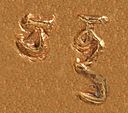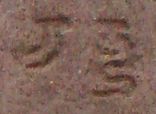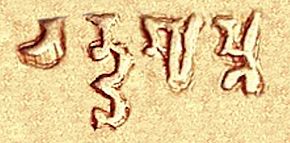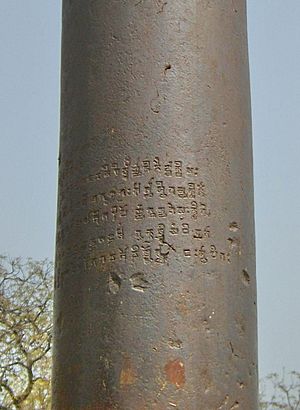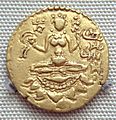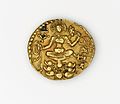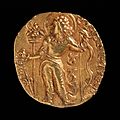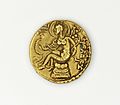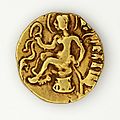Chandragupta II facts for kids
Quick facts for kids Chandragupta II |
|
|---|---|
| Vikramaditya Bhattaraka Maharajadhiraja Deva-raja |
|
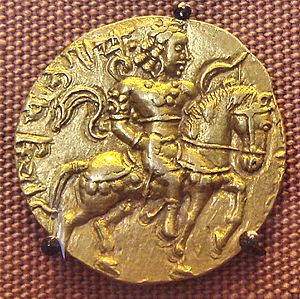
An 8 gram gold coin featuring Chandragupta II astride a caparisoned horse with a bow in his left hand. The name Cha-gu-pta appears in the upper left quadrant.
|
|
| Gupta Emperor | |
| Reign | c. 375 – c. 415 CE |
| Predecessor | Samudragupta, possibly Ramagupta |
| Successor | Kumaragupta I |
| Spouse | Dhruvadevi, Kuberanaga |
| Issue |
|
| Dynasty | Gupta |
| Father | Samudragupta |
| Mother | Dattadevi |
| Religion | Hinduism |
Chandragupta II (ruled around 375-415 CE) was a powerful emperor of the Gupta Empire in India. He was also known by his special title, Vikramaditya. He was the third ruler of the Gupta Empire and is considered one of the most important kings in Indian history.
Chandragupta II continued to expand his empire, just like his father Samudragupta. He mainly used military strength to do this. He defeated groups like the Western Kshatrapas. This helped him make the Gupta Empire stretch from the Indus River in the west to the Bengal region in the east. It also reached from the Himalayan mountains in the north to the Narmada River in the south.
His daughter, Prabhavatigupta, became a queen in the southern Vakataka kingdom. Chandragupta II might have had some influence in that area when she was ruling.
The Gupta Empire was at its strongest and richest during Chandragupta II's time. A Chinese traveler named Faxian visited India when Chandragupta II was king. Faxian wrote that the kingdom was peaceful and wealthy. Many stories about the legendary king Vikramaditya are probably based on Chandragupta II. It is also thought that the famous poet Kalidasa might have been a poet in his royal court.
Becoming King and Expanding the Empire
Chandragupta was the son of Emperor Samudragupta and Queen Dattadevi. He took over the Gupta throne after his father.
He was a very successful military leader. Records say he "bought the earth" with his strength, meaning he conquered many lands. He made other kings his subjects. His empire stretched far and wide.
Victories in Western India
Chandragupta II had great success against the Western Kshatrapas. These were rulers in west-central India, also known as Shakas. We don't know the exact date of his victory. But it likely happened between 397 and 409 CE.
Because of this victory, Chandragupta extended his empire. It reached all the way to the Arabian Sea coast. This area is now part of Gujarat.
The Iron Pillar of Delhi
The famous Iron pillar of Delhi has an inscription about a king named "Chandra". Most experts believe this king is Chandragupta II. However, we cannot be completely sure.
If King Chandra is Chandragupta II, it means he marched through the Punjab region. He even went as far as the Vahlikas, which is Balkh in modern-day Afghanistan. But there is no proof that he added Punjab to his empire permanently. This suggests his victory there was not a final one. After his rule, there is little sign of Gupta power in Punjab. Coins show that small chiefs ruled Punjab after his death.
The inscription also suggests Chandragupta won battles in the Vanga area. This area is now part of the Bengal region. It's possible that a large part of Bengal became part of the Gupta Empire. This control might have lasted until the 6th century.
Life in the Gupta Empire
The Chinese traveler Faxian visited India during Chandragupta II's reign. He stayed in the Gupta kingdom for about six years. Faxian was mainly interested in Buddhist religious matters. He did not write down the name of the king.
His writings show an ideal picture of the Gupta government. Not everything he said can be taken as exact fact. But his description of a peaceful and wealthy kingdom seems generally true.
Faxian mentioned that most people did not eat meat. They also avoided strong drinks, onions, or garlic. The only exception was the untouchable Chandalas. They lived separately from others. When they entered a city, they would hit a piece of wood. This warned others to avoid touching them. Only the Chandalas worked in fishing and hunting. They were also the ones who sold meat. In general markets, there were no butcher shops. People did not keep pigs or chickens.
Historian R. C. Majumdar believes Faxian's notes on food habits might be about Buddhist religious groups. They might not apply to everyone in the general public.
Faxian also noted that people used cowries to buy and sell things.
Pataliputra and Charity
Faxian described the Pataliputra region as the richest part of the Middle Kingdom. He said its people were kind and fair. He wrote about an annual Buddhist festival. This festival included a parade of 20 large carts with Buddhas. The Brahmanas would invite the Buddhas into the city. There were also music performances.
He mentioned that in the cities, wealthy Vaishya leaders had set up centers for charity and medical help. These centers helped the poor, orphans, widows, and sick people. Doctors examined them and gave them food and medicine until they got better.
Family Life
Gupta records say that Dhruvadevi was Chandragupta's queen. She was the mother of his son and successor, Kumaragupta I.
Chandragupta also married Kuvera-naga, also known as Kuberanaga. Her name suggests she was a princess from the Naga dynasty. This dynasty was powerful in central India before Samudragupta defeated them. This marriage might have helped Chandragupta make his empire stronger. The Nagas might have also helped him in his war against the Western Kshatrapas.
Religious Beliefs
Many gold and silver coins of Chandragupta show his religious devotion. Inscriptions from him and later rulers also describe him as a parama-bhagvata. This means he was a strong follower of the god Vishnu.
One of his gold coins, found at Bayana, calls him chakra-vikramah. This means "powerful because he has the discus." The coin shows him receiving a discus from Vishnu.
Even though he was a strong follower of Vishnu, Chandragupta was also respectful of other religions.
The Legendary Vikramaditya
Vikramaditya is a famous legendary emperor in ancient India. He is known as the perfect king. People remember him for his kindness, bravery, and for supporting scholars. Many historians believe that some of the stories about Vikramaditya are based on Chandragupta II.
Some coins and an inscription on the Supia pillar suggest that Chandragupta II used the title "Vikramaditya."
The legendary Vikramaditya is said to have defeated the Śaka invaders. Because of this, he was called Śakari, meaning "enemy of the Śakas." Chandragupta II conquered Malwa after defeating the Western Kshatrapas, who were a branch of the Śakas. He also drove the Kushanas out of Mathura. His victories over these foreign groups were probably turned into the exciting stories about Vikramaditya.
Most legends say Vikramaditya's capital was Ujjain. But some stories say he was king of Pataliputra. The Guptas had their capital at Pataliputra. Historian D. C. Sircar thinks Chandragupta II might have defeated the Shaka invaders of Ujjain. He might have then placed his son Govindagupta as a governor there. This could have made Ujjain a second capital for the Gupta empire. Later, legends about him (as Vikramaditya) might have grown from this.
The Vikram Samvat Calendar
The Vikrama Samvat is an Indian calendar era that started in 57 BCE. It is linked to the legendary Vikramaditya. However, this link did not exist before the 9th century. Earlier sources called this era by different names. These included Kṛṭa, the era of the Malava tribe, or simply Samvat.
Scholars like D. C. Sircar and D. R. Bhandarkar believe the era's name changed to "Vikram Samvat" after Chandragupta II's rule. This is because he had taken the title Vikramaditya.
Images for kids
-
The pillar inscribed with the Lakulisa Mathura Pillar Inscription, Mathura recording the installation of two Shiva Lingas by Udita Acharya in the "year 61 following the era of the Guptas in the reign of Chandragupta Vikramaditya, son of Samudragupta" (380 CE). Rangeshwar Temple. Mathura Museum.
-
The iron pillar of Delhi, which features an inscription of king Chandra, identified as Chandragupta II. It was installed as a victory pillar in the Qutb complex by Sultan Iltutmish in the 13th century.
-
One of the earliest dated Gupta statues, a Bodhisattva derived from the Kushan style of Mathura art, inscribed "year 64" of the Gupta era, 384 CE, Bodh Gaya.
-
Chandragupta II is associated with the development of Vaishnavism in India, and the establishment of the Udayagiri Caves with Vaishnava iconography (here Varaha saving the world from chaos). Circa 400.
-
Coin with the king's name in Brahmi script
-
Silver coin in Western Satraps style (15mm, 2.1 grams.)
See also
 In Spanish: Chandragupta II para niños
In Spanish: Chandragupta II para niños


